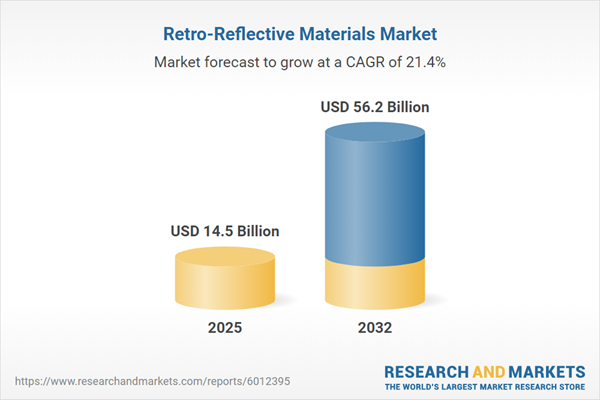Speak directly to the analyst to clarify any post sales queries you may have.
Retro-reflective materials are accelerating innovation across safety, automotive, industrial, and consumer sectors, providing enhanced visibility and forming an essential component in critical infrastructure and next-generation smart technologies.
Market Snapshot: Retro-Reflective Materials Market Growth and Outlook
The retro-reflective materials market continues to demonstrate robust expansion, driven by rising safety demands, regulatory shifts, and technological advances worldwide. With a strong growth trajectory and notable CAGR, this market is positioned for significant value creation across regions and applications. Current trends include expansion beyond traditional road safety into electronics, wearable devices, advanced coatings, and digital integration, leading to new competitive landscapes and innovative partnerships among major stakeholders.
Scope & Segmentation: In-Depth Review of Retro-Reflective Materials Ecosystem
- Material Types: Acrylic beads, ceramic beads, glass beads, glass flakes, and microspheres, each offering unique optical performance and durability for a range of use cases.
- Product Forms: Coated fabrics (nonwoven, woven), films, pellets, sheets, tapes—encompassing both advanced manufacturing techniques and established production processes.
- End Use Industries: Aerospace, automotive, industrial safety (including protective clothing, safety helmets, and traffic control devices), personal protective equipment, and road safety (covering pavement markers, road marking, and traffic sign applications).
- Distribution Channels: Direct, distributor, and online models, providing flexibility in procurement and supporting both customized and rapid fulfillment requirements.
- Regions Covered: Americas (with North America and Latin America), Europe, Middle East, Africa, and Asia-Pacific—encompassing major economies and targeting local regulatory conditions, sustainability goals, and urbanization trends.
- Key Companies Analyzed: 3M Company, Avery Dennison Corporation, Nippon Carbide Industries Co., Ltd., ORAFOL Europe GmbH, Changzhou Hua R Sheng Reflective Material, Paiho Group, Coats Group Plc, Asian Paints PPG, Reflomax, YGM.
Key Takeaways for Strategic Decision-Makers
- Retro-reflective materials are increasingly integrated into smart infrastructure and connected mobility platforms, supporting data-driven safety management and real-time monitoring.
- Innovation is expanding use cases, including bio-based formulations and advanced polymers that address both environmental impact and high-performance requirements.
- Strategic geographic positioning is necessary, as regional regulatory pressures and infrastructure investments are shaping demand and adoption rates differently across global markets.
- Partnership models, particularly between material science specialists and OEMs, are accelerating product iteration, testing, and customization—yielding premium offerings tailored to highly regulated sectors.
- Supply chain resilience and manufacturing agility are key competitive differentiators, especially as companies respond to evolving trade policies and increased scrutiny of origin and sustainability credentials.
Tariff Impact on Supply Chains and Cost Structures
Recent U.S. tariff adjustments have added complexity to procurement and sourcing of glass-based materials. Domestic producers are investing in vertical integration and local manufacturing to mitigate exposure to international duties, while downstream stakeholders are considering alternative materials and balancing cost, quality, and lead times. This adaptability is enabling some firms to maintain margins and ensure product quality despite shifting trade frameworks.
Methodology & Data Sources
Analysis is grounded in a combination of primary research—including direct interviews with R&D specialists, procurement leads, and end users—and secondary research from industry publications, patent filings, and technical white papers. Value chain mapping, SWOT analysis, and technology readiness assessments validate findings for use in strategic planning.
Why This Report Matters
- Enables leaders to target emerging opportunities and address compliance by anticipating trends in sustainability, technology, and supply chain management.
- Equips stakeholders to benchmark strategies against industry leaders, optimize procurement, and allocate resources based on current and emerging regional market drivers.
Conclusion
This comprehensive analysis offers decision-makers a strategic foundation to pursue growth, assess risk, and unlock value in the evolving retro-reflective materials market. Active alignment with emerging trends positions organizations to secure competitive advantages and adapt to continuous change.
Additional Product Information:
- Purchase of this report includes 1 year online access with quarterly updates.
- This report can be updated on request. Please contact our Customer Experience team using the Ask a Question widget on our website.
Table of Contents
3. Executive Summary
4. Market Overview
7. Cumulative Impact of Artificial Intelligence 2025
Companies Mentioned
The companies profiled in this Retro-Reflective Materials market report include:- 3M Company
- Avery Dennison Corporation
- Nippon Carbide Industries Co., Ltd.
- ORAFOL Europe GmbH
- Changzhou Hua R Sheng Reflective Material
- Paiho Group
- Coats Group Plc
- Asian Paints PPG
- Reflomax
- YGM
Table Information
| Report Attribute | Details |
|---|---|
| No. of Pages | 193 |
| Published | November 2025 |
| Forecast Period | 2025 - 2032 |
| Estimated Market Value ( USD | $ 14.5 Billion |
| Forecasted Market Value ( USD | $ 56.2 Billion |
| Compound Annual Growth Rate | 21.3% |
| Regions Covered | Global |
| No. of Companies Mentioned | 11 |









